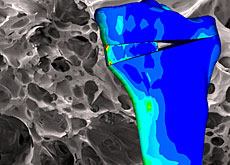Researchers claim bone repair breakthrough

Researchers in Switzerland say they have developed a new composite material with properties similar to bone.
The discovery offers hope for patients needing bone transplants, with the material expected to be ready for medical use in five years’ time.
The artificial tissue, developed by teams at the Federal Institute of Technology in Lausanne and the city’s University Hospital, will now be tested on animals.
“The synthetic material developed by us is the result of three years of intensive work and hundreds of tests,” commented project coordinator Dr Pierre-Etienne Bourban.
According to the Swiss National Science Foundation, the new substance could be used in cases where there is a large loss of bone tissue, for example after a serious accident.
Until now, bone grafts have usually come from the patients themselves or from dead donors. But this carries the risk of an illness being passed on.
Composite material
The “bioresorbable synthetic bone matter” is a composite material made up of plastic and ceramic particles that strengthen it. On its own the polymer would not be stiff enough; ceramic alone would be too brittle.
The material has a similar structure to bone in that it is porous inside and more compact on the outside.
“We had to test countless polymer/ceramic combinations to produce the optimal material,” explained Bourban.
According to the National Science Foundation, the properties of both polymer and ceramic can be combined into a material that will be accepted by the human body.
In experiments, researchers put the material together with human bone cells, which resulted in an increase in the number of cells.
The material proved to be biocompatible and supported the formation of new bone tissue.
“There are already artificial bones in existence, but they often have disadvantages,” Dr Dominique Pioletti at the Lausanne institute’s orthopaedic research laboratory told swissinfo.
“They are, for example, not solid enough. The material that we are putting forward has high mechanical properties and is porous at the same time. That is what is new,” he added.
Tissue replacement
Pioletti explained that after an accident, or in the case of a tumour, there was often a void in the bone.
“If you do nothing, the patient cannot walk. You have to colonise this void with material that allows the conservation of the patient’s physical being at the same time as allowing the cells to colonise the material.”
“You have to give support to the cells so that they colonise the material which will then be absorbed naturally. A new bone will progressively be formed,” he added.
Pioletti told swissinfo that there were different possible applications for the material but the most frequent uses could be with hip and knee implants.
“These implants last for several years, but there is a loss of bone structure around them. In such a case, our material could also be used,” he explained.
swissinfo with agencies
The teams at the Federal Institute of Technology in Lausanne and at the city’s University Hospital spent three years on their research.
Testing on animals is now going to be carried out.
The material should be ready for medical use in five years’ time.
Researchers in Lausanne have developed a new material which has similar properties to bone.
It is made out of a combination of plastic and ceramic.
The material can be used as a kind of temporary bone until natural bone tissue regrows.

In compliance with the JTI standards
More: SWI swissinfo.ch certified by the Journalism Trust Initiative

You can find an overview of ongoing debates with our journalists here. Please join us!
If you want to start a conversation about a topic raised in this article or want to report factual errors, email us at english@swissinfo.ch.